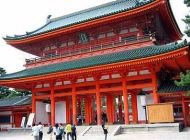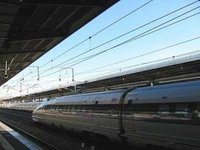Japan is a joy to visitSTORY & pictures BY K. KASTURI DEWITHE idea of travelling to Japan at a time when the powerful typhoon Nabi was churning towards the country was far from comforting.
But the fact that Japan was hit by 10 typhoons in the past year meant it would be a while before I could visit a typhoon-free Japan. However, an official from Japan’s Foreign Affairs Ministry (MOFA), the organiser of the 10-day tourism promotion campaign, assured us 10 Asian journalists we would be safe.

Visiting a Shinto temple in Tokyo.
Japan – comprising Honshu, Shikoku, Kyushu and Hokkaido islands – is one of the most captivating nations in the world.
To me, it has always been an enthralling blend of development, natural beauty and unique cultural heritage.
The trip, which took me from Tokyo – one of the world’s largest cities – to Nagoya, Kyoto, Osaka and the northern island of Hokkaido revealed how the island nation and its people have managed to put aside the undercurrents of the past to adopt a distinctive style of living.
Recently, government planners have been concerned with the growing population of Japanese who are living longer and having fewer children.
The number of people aged 65 and above now stands at 15% of the total population of 120 million and is expected to reach 25% by 2020.
Tokyo, known, as Edo during Imperial Japan, is still very much a developing city with a unique administration system. It covers 617sq m.
Our hotel, the Keio Plaza Hotel, is located in Shinjuku, one of the largest urban towns in Tokyo.
Our knowledgeable tour guide Cheiko Sakihana explained that Shinjuku, which literally means “new place to stay’’, boasts one of the world’s busiest train stations, handling more than 1 million commuters daily.
The station is considered to be a major transfer point for both metropolitan and regional trains and for subways.
It was indeed an eye-opening experience to see the Japanese commuting on the trains during the morning rush hour.
I felt like a mole burrowing my way through one subway after another, joining millions of Japanese as they rushed to catch their trains.
Tokyo is not all state-of-the-art technology, where elevated highways practically stare you in the face when you open your front door or window.
Here, one can also appreciate the festivals, botanical parks, museums, amusement parks such as Tokyo Disneyland and Tokyo Disney Sea, and theatres such as the Kabuki-za, a venue for Kabuki located in Ginza, centre of entertainment and shopping.
 The shinkansen(bullet train) has become a symbol of modern Japan.
The shinkansen(bullet train) has become a symbol of modern Japan.From hectic Tokyo, we travelled in our comfortable coach for the next six hours to the spa resort of Fujikawaguchiko, at the foothills of Mt Fuji.
It was unfortunate that we could not see the tip of Mt Fuji in all its splendour as the heavy rains brought by the typhoon had created a mist over the mountain range.
Fujikawaguchiko has five lakes referred to as the Fuji Five Lakes comprising Lake Kawaguchiko, Lake Saiko, Lake Shojiko, Lake Motosuko and Lake Yamanakako.
This tourist spot has hot springs, art museums and craft workshops.
One of the main attractions is the Herb Festival, which features herbs and flowers of all colours and shapes.
The 15th anniversary of the Kawaguchiko Herb Festival will be held from June 16 to July 13 next year.
The Kyomai is a Kyoto-style dance which one can catch at the Kyoto Traditional Musical Theatre.The next day, we boarded our coach for the Aichi Prefecture in the Chubu region of Nagoya.
Aichi is rich in culture and history and enjoys a mild climate. It is the birthplace of the three Shoguns who shaped Japan’s pre-modern history, namely Odu Nobunaga, Toyotomi Hideyoshi and Tokugawa Ieyasu.
The Aichi area was one of Japan’s leading castle towns during the Edo period. Among the famous is the Nagoya Castle, the symbol of Nagoya.
The castle was built in 1612 by Tokugawa Ieyasu and features a pair of golden shachihoko (legendary dolphin-like fish) perched on the castle roof.
The next morning, we visited the 2005 World Exposition Aichi Japan.
This first world exposition of the 21st century was held from March 25 to Sept 25.
Pavilions and exhibits were spread out over the Nagakute Area in Nagakute town and Toyota city, and the Seto Area in Seto city.
Some 121 countries including Japan and four international organisations participated in the expo, themed “Nature’s Wisdom’’.
The international event was held to pool together the knowledge and experience of mankind and explore the power of life and nature.
The most impressive pavilion, which drew the largest crowd, was the Toyota Group Pavilion.
The highlight was a 30-minute show staged in the pavilion’s main theatre.
The whole theatre was enveloped in darkness. This was followed by the rich sounds of trumpets, trombones and horns reverberating in the theatre.
The seven “musicians’’ on stage were actually robots developed by Toyota, playing When the Saints go Marching in.
The impressive show also featured the “i-foot’’, a two-legged robot that could carry a human rider – a notable feature of the Expo.
It was truly a memorable visit. The last time a similar event of such magnitude was held was in Osaka in 1970. W
Old & newUnlike Tokyo, where a visitor is surrounded by concrete jungles and neon lights, a visitor to Kyoto can marvel at pebble gardens, the intricate and sensuous contours of a temple roof or simply catch a glimpse of a geisha.
The city also boasts 2,000 temples and shrines, palaces and dozens of gardens and museums.
Kyoto, which was spared bombings during World War II, remains an important cultural and educational centre of Japan.
It is also home to 17 Unesco World Heritage sites.
At the Gion Corner, I had a taste of Japanese traditional arts and entertainment at the Kyoto Traditional Musical Theatre.
Since 1962, Gion Corner has been a popular nightspot where tourists can enjoy Japanese traditional arts such as Bunraku (Puppet Play), Kyomai (Kyoto Style Dance), Kyogen (Traditional Comic Play) and Gagaku (Court Music).
Tourists can also witness Kado, the art of floral arrangement, Chado tea ceremony and the serenading sounds of the Japanese harp, Koto.
On our way back to our hotel –the Kyoto Brighton Hotel at Gion Corner, we chanced upon a geiko (or geisha).
Just as our coach was making a turn, our guide, Cheiko-san spotted a geiko crossing the road and we practically jumped out of our seats to get a glimpse.
I was reluctant to leave Kyoto as there was just too much to see and explore.
We moved on to Osaka, a modern Japanese city that combines historical and cultural attractions.
The Osaka Prefecture, one of the nine Prefectures in the Kansai region, has a population of 8.81 million, the second highest in Japan.
The Osaka city itself was once a major port and mercantile centre and is today Japan’s second most important metropolis.
Our guide, who hails from Osaka, said despite the locals’ entrepreneurial spirit and sense of independence, the Osaka people are easy-going, open-minded and down-to-earth.
On the last leg of our tour, we took a domestic flight from Osaka to Hokkaido to visit the Shiretoko National Park.
The 386sq m park, covers most of this remote volcanic peninsula jutting into the Sea of Okhotsk.
To the indigenous population of Hokkaido, known as the Ainu, Shiretoko means “end of the world”.
The peninsula’s natural beauty with its pristine landscape is indeed a sight to behold.
The government’s efforts in preserving the forests and rivers resulted in Shiretoko being inscribed onto the World Heritage List this year.
To explore most of the park, a car or motorcycle is necessary.
At the start of our trail to one of the five lakes in the park, our guide Kanako Arai reminded us to stay calm if we were approached by brown bears.
As our group moved along, we spotted claw marks on the tree trunks indicating that bears had tried to climb the trees.
The park, which attracts visitors between May and October, is home to brown bears, shikadee dears, foxes and blackstov fish.
Our 10-day sojourn finally came to an end. Despite the whirlwind trip, it was with a heavy heart that I bade farewell to the land of the Rising Sun.– By K.KASTURI DEWI